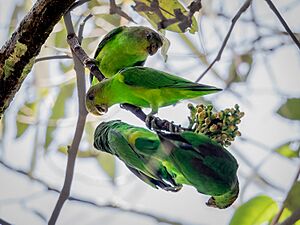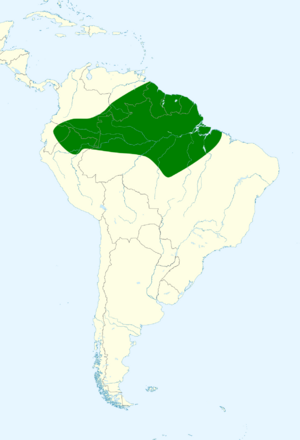Sapphire-rumped parrotlet facts for kids
Quick facts for kids Sapphire-rumped parrotlet |
|
|---|---|
 |
|
| Conservation status | |
| Scientific classification | |
| Genus: |
Touit
|
| Species: |
purpuratus
|
 |
|
The sapphire-rumped parrotlet (Touit purpuratus) is a small, colorful bird. It belongs to the parrot family and is found in parts of South America. You can find these birds in countries like Brazil, Colombia, Ecuador, French Guiana, Guyana, Peru, Suriname, and Venezuela.
Contents
About Its Name
The sapphire-rumped parrotlet got its scientific name, Touit purpuratus, a long time ago. The word Touit comes from an old language spoken by native people in Brazil. It means "really little parrot." The word purpuratus is Latin, meaning "clad in purple." This name probably refers to the purple or violet colors on the bird.
There are two slightly different types, or subspecies, of the sapphire-rumped parrotlet. They are called T. p. purpuratus and T. p. viridiceps.
What It Looks Like
This parrotlet is about 17 to 18 centimeters (7 inches) long. It weighs between 54 and 66 grams (about 2 ounces). Most of its body is green. The green is darker on its back and lighter on its belly.
A cool feature is its blue lower back and rump. This is where it gets the "sapphire-rumped" part of its name! Both types of this parrotlet have a white ring around their eyes. When their wings are folded, you can see a "V" shape on their back. Males have darker "V" shapes than females. The middle tail feathers are green, and the other tail feathers are red with black tips. Young parrotlets look a bit like females but are not as brightly colored.
Where It Lives
The sapphire-rumped parrotlet lives in northern South America. One type, T. p. purpuratus, is found from Venezuela across the Guianas and northern Brazil. The other type, T. p. viridiceps, lives in parts of Venezuela, northwestern Brazil, southeastern Colombia, eastern Ecuador, and northeastern Peru.
These parrotlets like to live in different kinds of forests. In some areas, they live in evergreen mountain forests up to about 1,400 meters (4,600 feet) high. In other places, they prefer lowland rainforests. They can also be found in savannas or small patches of woods.
Behavior
Movement
Scientists don't know much about how far or how often sapphire-rumped parrotlets move. Their exact travel patterns are still a mystery.
Feeding Habits
The sapphire-rumped parrotlet mainly eats fruits. They especially like figs. They also eat fruits from several other types of plants. In some areas, they have been seen eating leaves, shoots, bark, and even dead wood.
Reproduction
Sapphire-rumped parrotlets lay their eggs in March in Venezuela. In the Guianas, they may nest in April or November. They usually build their nests in holes in dead trees. Sometimes, they use nests made by termites in trees. It's thought that they lay three to five eggs at a time. We don't know much about how long the eggs take to hatch or how long the young birds stay in the nest.
Vocalization
When flying, the sapphire-rumped parrotlet makes a loud, nasal call that sounds a bit like a goose saying "nyaah." When many birds fly together, they make a continuous chattering sound. When they are resting on a branch, they can make a fast, rattling sound like "che-che-che."
Conservation Status
The IUCN (International Union for Conservation of Nature) says the sapphire-rumped parrotlet is a species of "Least Concern." This means it is not currently in danger of disappearing. It lives across a very large area. Even though we don't know exactly how many there are, their numbers seem to be stable. There are no big threats to them right now. They live in several protected areas, especially in Brazil. They are not often seen in large groups, but they are also good at hiding, so they might be more common than we think.


